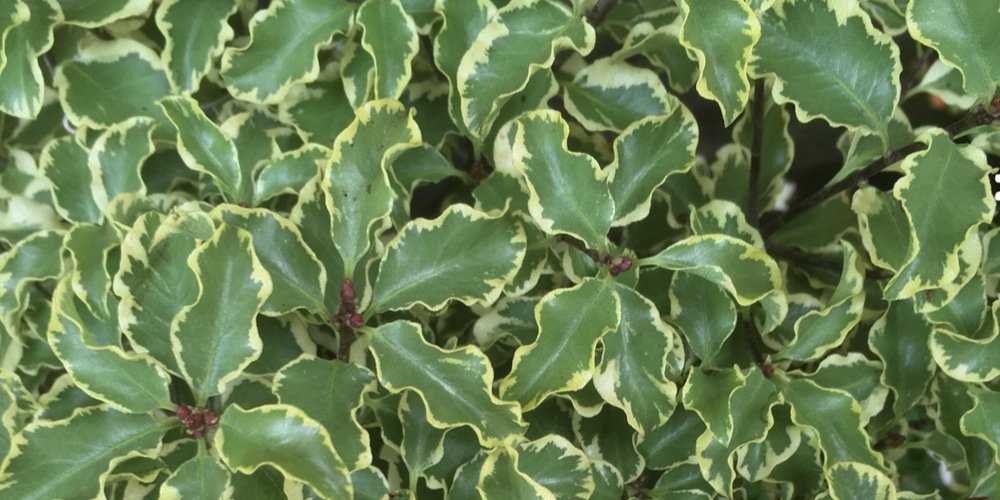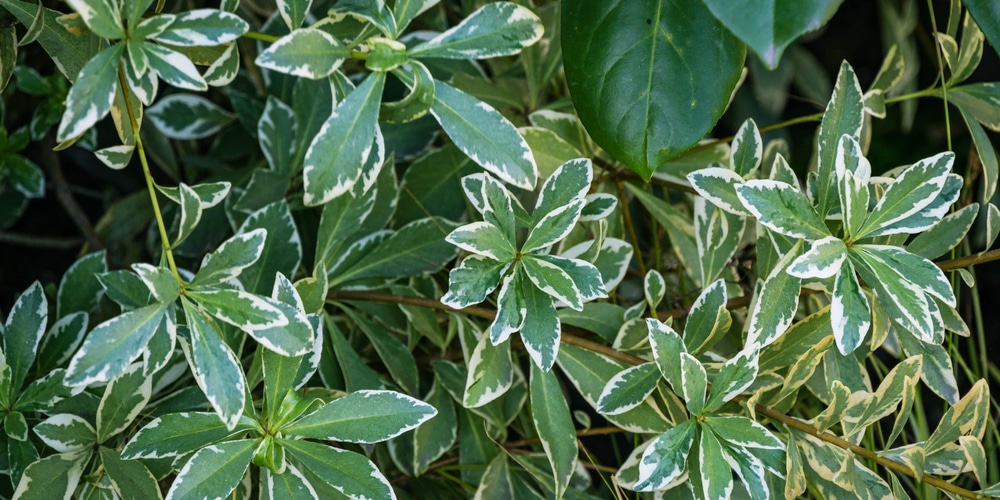The variegated pittosporum is a beautiful evergreen shrub. It’s perfect for adding a touch of color and interest to any garden and is relatively low-maintenance.
This shrub can grow to around 8 feet tall and has oval-shaped leaves with creamy white margins. The variegated pittosporum is also known as the Japanese pittosporum.
If you’re looking for a beautiful, low-maintenance addition to your garden, look no further than variegated pittosporum!
This article will discuss the benefits of adding variegated pittosporum to your garden and how to care for it. So if you’re ready to add some eye-catching color to your yard, keep reading!
Origin
The Variegated Japanese Pittosporum, also known as the Japanese mock orange, is a versatile and popular ornamental plant. Native to Japan and China, it has been introduced to Mediterranean climates worldwide. In the United States, it is most commonly found in the southern parts of Florida.
The Variegated Japanese Pittosporum is an evergreen shrub or small tree that can grow 8 feet tall. It has dark green leaves and fragrant white flowers bloom in the springtime. It can spread from six to eight feet.
With its attractive foliage and sweet-smelling blossoms, it is no wonder that the Japanese Pittosporum is such a popular landscaping choice.
Leaves
The tree’s leaves are one of its most distinct and defining features. The leaves are dark green and oval-shaped, with a glossy surface on one side and a matte finish on the other.
They’re also attached to the tree’s branches in a whorl-like pattern, which gives the tree a dense, bushy appearance. The leaves are slightly curled, with the glossy side facing outward.
The margins of the leaves are where the variegation comes in – they’re creamy white, giving the tree a two-toned look. The variegation is more pronounced on new growth, which tends to be lighter in color.
The tree’s leaves are also very smooth in texture, adding to their overall aesthetic appeal.
In addition to their physical features, the tree’s leaves also serve an important function in the life of the tree. Leaves are responsible for photosynthesis, which is how trees convert sunlight into energy. This process is essential for the tree’s survival, and it helps to make the tree’s leaves one of its most important organs.
Body (Twigs, Stems, And Bark)
The tree has a light gray or brown trunk and branches, and the bark is smooth and cannot be peeled off. The branches are slightly darker in color than the trunk but are still very similar in hue.
The pittosporum tobira has thin, straight twigs that can hold the weight of the leaves without breaking. The leaves of the tree are larger than average and grow in bunches.
Flowers And Fruits
The tree’s flowers bloom in bunches in mid-spring, around April or May. Each flower is small, averaging about 0.5 inches in diameter, with five petals of white to off-white coloring evenly surrounding a light green center. The blooms are not firmly attached to the tips of branches, and they can be easily blown off by a breeze. The flowers bloom in a pale yellow color as the tree ages.
The fruit on the tree is lighter green or yellow on the exterior with a woody shell. When cracked open, a bright red seed is revealed at the center. The fruits are relatively small, averaging about an inch in diameter. The tree is also popular for its ornamental value and is often planted as a decorative addition to gardens.
Caring For The Variegated Pittosporum
Variegated Japanese Pittosporum is a beautiful and popular plant that can be used in various ways in landscaping. It is relatively low maintenance, but there are some things you can do to ensure it remains healthy and looks its best:
Water
This tough plant is highly resistant to drought, making it a great choice for hot, dry climates. However, this drought resistance does not develop until the plant has established a deep and extensive root system.
Until this happens, the plant will need to be regularly watered. Once established, watering can be reduced to once per week or less, depending on soil conditions.
Soil
The Variegated Japanese Pittosporum prefers well-drained soil, but it is not picky about the type of soil as long as it meets this requirement.
It will grow in sandy or clay soils and loamy soils. If your soil is particularly heavy, you may want to add some organic matter to help improve drainage.
Fertilizer
This tree is not a heavy feeder, so it does not require a lot of fertilizer. A general-purpose fertilizer applied once or twice a year should be sufficient.
If you notice the leaves beginning to yellow, this may be a sign that the tree is not getting enough iron. You can correct this by applying an iron sulfate solution to the soil around the tree.
Pruning
The Variegated Japanese Pittosporum can be pruned to maintain a desired shape or size. It can also be pruned to remove damaged or diseased branches.
Pruning should be done in late winter or early spring before new growth begins.
Diseases And Pests
The Variegated Japanese Pittosporum is a beautiful and versatile tree that can be used in various ways in landscaping. With proper care, it will thrive and provide years of enjoyment. This tree is relatively resistant to diseases and pests.
However, it can be susceptible to scale, aphids, and mealybugs. These pests can be controlled with a variety of insecticides or horticultural oils.
The key to keeping this tree healthy is to catch problems early and take action to correct them. With a little care, the Variegated Japanese Pittosporum can be a stunning addition to any landscape.
Landscape Uses
The variegated Japanese pittosporum is a beautiful, multi-purpose shrub that can add interest and privacy to any landscape.
A native of Japan, this evergreen plant has glossy green leaves with white margins. It is fast-growing and can reach heights of 6-8 feet.
The Variegated Japanese Pittosporum can be used as a border, hedge, privacy screen, or mass planting.
It is also salt tolerant and drought resistant, making it an ideal choice for coastal exposures or urban gardens.
With so many uses, the Variegated Japanese Pittosporum is versatile and valuable to any landscape.
Final Thoughts
The Variegated Japanese Pittosporum is a beautiful, versatile plant that can add interest and privacy to any landscape. It is fast-growing, salt-tolerant, and drought-resistant. With proper care, it will thrive and provide years of enjoyment.
Related Article: Zone 8 Shrubs


